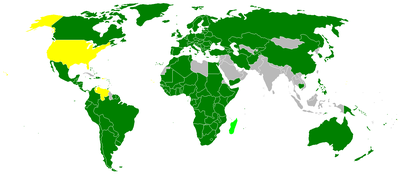Convention Relating to the Status of Refugees
The United Nations Convention Relating to the Status of Refugees is an international agreement that defines who is a refugee. It lists the rights of people who are granted asylum (allowed to live in another country because it is not safe to live in their home country). It also lists the responsibilities of countries that give asylum to refugees.

The Convention also says which people are not seen as refugees, like war criminals.
History change
The Convention was approved at a special United Nations conference on 28 July 1951. At first, it only talked about protecting European refugees after World War II. There were limits on how long the Convention would last, and who it protected. But in 1967, a "protocol" (change) to the Convention took away these limits. This protocol made the Convention apply to all refugees.
Because the convention was approved in Geneva, it is often called "the Geneva Convention." But it is not one of the more well-known Geneva Conventions that talk about what kind of behavior is allowed during wars.
Denmark was the first state to ratify (agree to) the treaty, on 4 December 1952. Today, 147 countries have agreed to the Convention, the Protocol, or both. (See the map on this page.)
Chapter I. Definition of a Refugee change
Chapter 1 is made up of Articles from 1 to 11. Article 1 of the Convention as updated by the 1967 Protocol, gives the definition of a refugee:
- "A person who owing to a well-founded fear of being persecuted for reasons of race, religion, nationality, membership of a particular social group or political opinion, is outside the country of his nationality and is unable or, owing to such fear, is unwilling to avail himself of the protection of that country; or who, not having a nationality and being outside the country of his former habitual residence as a result of such events, is unable or, owing to such fear, is unwilling to return to it.."[1]
This means a refugee is someone who is had to leave their home country because, if they stayed, they would be persecuted (treated badly) because of:
- Their race;
- Their religion;
- Their nationality;
- Being in a certain social group; or
- Having political beliefs that their government did not like
Chapter II. Juridical Status change
Chapter II is made up of Articles 12 to 16. These talk about:
- People's right to property (things they own)
- People's right to freedom of association (the freedom to be part of any social group or political party they want to be)
- Refugees' rights to be able to use the courts
Chapter III. Gainful Employment change
Chapter III talks about people's rights to work:
- Article 17 says everyone has the right to "wage-earning employment" (the right to work for pay)
- Article 18 says people also have the right to "self-employment"
- Article 19 says refugees have the right to "liberal professions"
Chapter IV. Welfare change
Chapter IV talks about refugees' rights to:
- Rationing (being given food) (Article 20)
- A place to live (Article 21)
- Public relief (Article 23)
- Good working conditions and social security (Article 24)
Chapter V. Administrative Measure change
Chapter V is made of Articles 25 to 34. These articles talk about the refugees' legal rights:
- Article 31 says that a refugee who has entered a country illegally should not be punished, if the refugee did this to escape from a threat to life or freedom
- Article 32 says that a country must not make any refugee leave the country just because of national security or public order. The country would have to have a specific reason to make that refugee leave the country.
- Article 33 talks about "Prohibition of expulsion or return" (called "refoulement" in French). That means no country can make a refugee leave or send them back to their home country, if in their home country their life or freedom would be in danger.
- Article 34 says that when a country takes refugees in, the country has to do everything it can to help the refugees assimilate and become naturalised (change their nationality to their new country).
References change
- ↑ "Archived copy" (PDF). Archived from the original (PDF) on 2010-03-31. Retrieved 2009-08-17.
{{cite web}}: CS1 maint: archived copy as title (link)